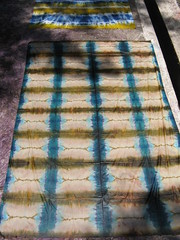Thursday, April 16, 2009
Batik, Ghana Cultural Centre, Ghana
This is the Batik Workshop at the Center for National Cutlure in Kumasi.
For the past month, I've been studying Batik every Tuesday and Wednesday at the Center for National Culture in Kumasi. My teacher is David Anokye (pron. a-NO-chay). I was studying with University of Kumasi (K.N.U.S.T) students who were getting a degree in Rural Arts. They were studying various traditional arts and were at the Centre for a couple of months.
There are also a couple students who were doing national service. Students who go to a government school spend a year of service. The government then assists them with school funding. Some students go into the military or work in hospitals. These students were studying tradional arts.
The Batik at the Center for National Culture uses cotton as their main fabric. It is usually cut in yard lengths. Wax is applied to resist the dyes. Where the wax is applied, the color of the fabric will remain the same. The first wax applied to a white piece of cotton will maintain the white color of the cotton where ever the wax is.
Foam sponges, brushes, and wooden stamps are used to apply the hot wax. The wax needs to be hot in order to adhere to the fabric and also dissolve into it and through it. We use a charcoal burner to heat the wax.
My teacher, David Anokye, using a cut piece of foam sponge to apply lines of hot wax to the cotton fabric.
The wooden stamps are mainly Adinkra symbols. There are sixty symbols on the chart that I am using. These Adinkra symbols in Ghana are used to represent a moral, a teaching, or something related to a cultural trait. The ladder symbol called Owuo Atwedie Baako Nto (obiara bewu) means "All men shall climb the ladder of death." The heart shaped symbol called "Akoma" means, "Have patience." You can learn more about them at the website: www.adinkra.org
These symbols are seen all over the places I've been in Ghana. They are used on packaging, on clothing, on walls of houses and businesses, and many other places.
After the initial wax is applied, then the fabric is folded and places into a plastic bucket of dye. The dying process usually goes from light colors to dark. At the Centre, we have been applying three different colors of dye.
The fabric is kept in the bucket of dye for about 10 minutes turning it every 4 minutes or so. Then, it is layed out to dry. After it is dry, then wax can be applied to the design where you want the first color to remain.
After all dying is complete, the fabric is placed in very hot water to remove the wax. Then, it is placed in cold water and layed out to dry.
Tie and dye is also another Batik technique. I've seen strings, plastic bags, and rocks used to creat different effects
Here is an example of tie and dye. The fabric is folder and only the edges are placed in the dye.
Besides batik, the center also has programs in weaving, pottery, wicker, wood carving, and drumming and dancing. They have painters and crafts people also selling their work, and there are many giftshops.
Subscribe to:
Post Comments (Atom)



Daniel...greetings from Pomona, CA !
ReplyDeleteWhat an amazing experience. I'll have more to say once I have a chance to absorb everything you've written so far. Your photos are great, too!
You might want to take a look @ a mutual friend's blog; I think you'll recognize the work.
http://errorshortstop.blogspot.com/
More later...
J&G
Dan,
ReplyDeleteThanks for posting!!!
I am loving seeing it all.
Mucho Love,
K